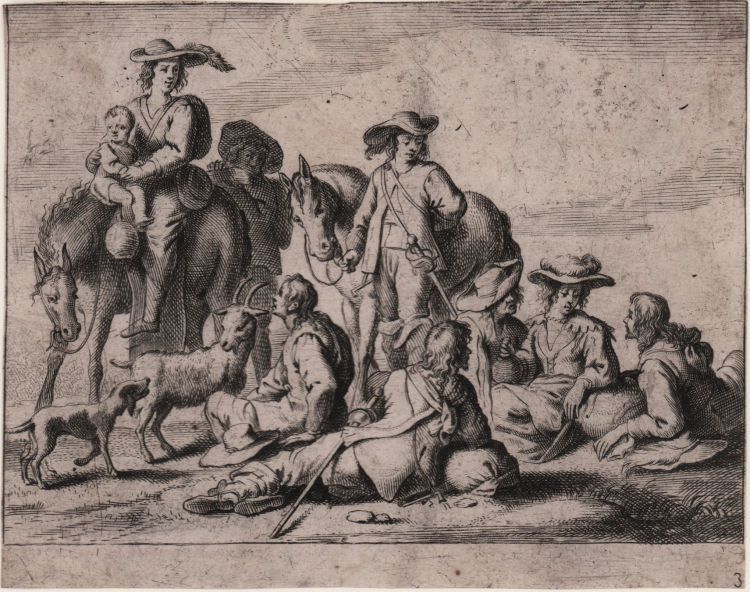



| Reference: | S37789 |
| Author | Cornelis II Bloemart |
| Year: | 1625 ca. |
| Measures: | 140 x 115 mm |


| Reference: | S37789 |
| Author | Cornelis II Bloemart |
| Year: | 1625 ca. |
| Measures: | 140 x 115 mm |
Etching, 1625, without signature. Numbered 3 at lower right. A proof state, before the letter.
Fine impression, printed on contemporary laid paper, trimmed to the platemark, good condition.
From a series of sixteen numbered plates showing genre scenes engraved by Cornelis Bloemaert after his father's designs Abraham Bloemaert (Roethlisberger 297-312). They all show Latin distichs by Hendrik de Roij in the lower margin. This series has later been published by Isack Greve in Amsterdam.
Cornelis Bloemaert II (1603 – 28 September 1692), was a Dutch Golden Age painter and engraver. Bloemaert was born at Utrecht. He studied with his father, Abraham Bloemaert, his brothers Hendrick and Adriaan, and his father's pupil, Gerard van Honthorst. Though originally trained as a painter, he devoted himself primarily to printmaking, which he learned from Crispijn van de Passe. He went to Paris in 1630, where he made engravings from among others, Michel de Marolles's Temple des Muses, before going to Rome in 1633. His chisel can be recognised by the colours' richness and the smoothness of their transitions. Amongst his pupils were Michel Natalis and Gilles Rousselet. Some of his better known engravings are of Annibale Carracci's The Holy Family, Pietro da Cortona's Adoration of the Shepherds, and Rubens' Meleager. According to Houbraken he traveled to Rome, where he made prints of many Italian paintings. During 1664-1677, working with Charles de la Haye, he completed engraving of the Pietro da Cortona frescoes in the Palazzo Pitti, published as Heroicae Virtutes Imagines quas eques Petrus Beretinus pinxit Florentiae (1677). In 1659 and 1667 he did frontispiece engravings for Daniello Bartoli's Istoria della Compagnia di Gesu. He was so successful that he stayed there until receiving word that his father wished to see him once more before he died. He delayed his return so long, that his father died, so he remained in Rome until his own death. He was a member of the Bentvueghels with the nickname Winter.
Bibliographic references
Roethlisberger 1993 / Abraham Bloemaert and his sons: Paintings and prints; Hollstein / Dutch and Flemish etchings, engravings and woodcuts c.1450-1700 (212-215)
Cornelis II Bloemart (Utrecht 1603 - Roma 1682)
|
Cornelis Bloemaert II (1603 – 28 September 1692), was a Dutch Golden Age painter and engraver. Bloemaert was born at Utrecht. He studied with his father, Abraham Bloemaert, his brothers Hendrick and Adriaan, and his father's pupil, Gerard van Honthorst. Though originally trained as a painter, he devoted himself primarily to printmaking, which he learned from Crispijn van de Passe. He went to Paris in 1630, where he made engravings from among others, Michel de Marolles's Temple des Muses, before going to Rome in 1633. His chisel can be recognised by the colours' richness and the smoothness of their transitions. Amongst his pupils were Michel Natalis and Gilles Rousselet. Some of his better known engravings are of Annibale Carracci's The Holy Family, Pietro da Cortona's Adoration of the Shepherds, and Rubens' Meleager. According to Houbraken he traveled to Rome, where he made prints of many Italian paintings. During 1664-1677, working with Charles de la Haye, he completed engraving of the Pietro da Cortona frescoes in the Palazzo Pitti, published as Heroicae Virtutes Imagines quas eques Petrus Beretinus pinxit Florentiae (1677). In 1659 and 1667 he did frontispiece engravings for Daniello Bartoli's Istoria della Compagnia di Gesu. He was so successful that he stayed there until receiving word that his father wished to see him once more before he died. He delayed his return so long, that his father died, so he remained in Rome until his own death. He was a member of the Bentvueghels with the nickname Winter.
|
Cornelis II Bloemart (Utrecht 1603 - Roma 1682)
|
Cornelis Bloemaert II (1603 – 28 September 1692), was a Dutch Golden Age painter and engraver. Bloemaert was born at Utrecht. He studied with his father, Abraham Bloemaert, his brothers Hendrick and Adriaan, and his father's pupil, Gerard van Honthorst. Though originally trained as a painter, he devoted himself primarily to printmaking, which he learned from Crispijn van de Passe. He went to Paris in 1630, where he made engravings from among others, Michel de Marolles's Temple des Muses, before going to Rome in 1633. His chisel can be recognised by the colours' richness and the smoothness of their transitions. Amongst his pupils were Michel Natalis and Gilles Rousselet. Some of his better known engravings are of Annibale Carracci's The Holy Family, Pietro da Cortona's Adoration of the Shepherds, and Rubens' Meleager. According to Houbraken he traveled to Rome, where he made prints of many Italian paintings. During 1664-1677, working with Charles de la Haye, he completed engraving of the Pietro da Cortona frescoes in the Palazzo Pitti, published as Heroicae Virtutes Imagines quas eques Petrus Beretinus pinxit Florentiae (1677). In 1659 and 1667 he did frontispiece engravings for Daniello Bartoli's Istoria della Compagnia di Gesu. He was so successful that he stayed there until receiving word that his father wished to see him once more before he died. He delayed his return so long, that his father died, so he remained in Rome until his own death. He was a member of the Bentvueghels with the nickname Winter.
|